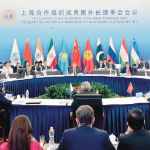President Putin’s recent visit to China was aimed at further strengthening the strategic compact between the two nations—the slew of agreements signed do point towards ‘A new era’, but the larger signalling is that of an unprecedented challenge to American hegemony. The prospect of a decline in American power is pushing Russia and China closer in the hope of hastening the latter’s fall. Even as Russia seeks to bring the existing order down, China promises an alluring new one. Three decades after the end of the Cold War, much against Kissinger’s advice, the United States (US) finds itself in a volatile rivalry with Russia and China, all together and all at once. So great is the state of dysfunctionality that there is every possibility of the world getting divided into two sets of rules, economies, and technologies. While the slogan is multi-polarity, other interlocking partnerships are being used to forge a wider Axis—on one hand, Iran and North Korea are supplying weapons to prop up Russia militarily and on the other, we see a growing Eurasian alignment as Russian and Chinese footprints in West Asia enlargens. Resident powers in theatres—China in the Western Pacific, Russia in Europe and Iran in West Asia—are checkmating the foundational precept of American power: the freedom of the American military to roam the globe. Concurrent escalation in all three theatres is fragmenting American power and complicating its strategic military response: Do the Americans fight in three or focus on winning in one? The US’s failing deterrence (Afghanistan, Ukraine, West Asia and prospectively in Taiwan) and its eroding power—every time America say don’t, Russia, Israel, Houthis, Hezbollah and Iran seem to comply only in the breach is quite evident. America’s debt servicing at US$1 trillion annually is larger than its defence budget, making the prospect of resurging the American defence enterprise a difficult proposition. The collective nuclear arsenals of China, Russia, Iran, and North Korea, in a few years, will be twice the size of the US. The New Axis has not only done far better than the West in the Ukrainian and West Asian theatres but is also shifting the battle for influence, business, and commerce to the Global South as its wider areas of action, with BRICS as a delivery platform. A Chinese commentator, Eric Lee, claims that Chinese ambitions are modest in relation to its weight—‘‘We do not want to run the Asia-Pacific, leave alone the world’’ he states. Aggression and hegemonic ambitions are not Chinese culture he asserts, “We built the Great Wall to keep the barbarians out, not to invade them.” Chairman Mao, back in 1944, had said “China must industrialize, this can only be done through free enterprise. Chinese and American interests fit together, economically and politically. America need not fear that we will not be co-operative. We cannot risk crossing America; we cannot risk any conflict.” Mao’s successors first beat the US at its own game—capitalism, and are now in bed with its bête noire Russia to challenge the American-led order. So, where do the twin narratives—those of American decline and the Chinese rise and stall—take us? The US continues to be a formidable entity as also a comeback nation: It accounted for 25 percent of the global GDP in 1980; it still does. The Chinese economy has grown at the expense of Europe and others, not the US. The US has more oil than Iran, and more gas than Qatar; it is demographically vibrant; it still boasts of the top seven Big Tech companies of the world. It is the only country with a global military reach—800 bases, 11 aircraft carriers, and a whopping outlay of US$950 billion. The Chinese miracle, on the other hand, is now enveloped by malaise. A long period of slowing growth, ballooning debt (287 percent of GDP), rising unemployment (50 percent), a party-market standoff, the taking down of Big Tech, the flight of FDI, and endless bouts of military cleansing have characterised the downward spiral. The number of elderly people in China exceeds the entire population of the US. In the coming decades, China could be more of a nursing home than an economic powerhouse.
US, Russia, China & New World Order

Sign Up For Daily Newsletter
Be keep up! Get the latest breaking news delivered straight to your inbox.
By signing up, you agree to our Terms of Use and acknowledge the data practices in our Privacy Policy. You may unsubscribe at any time.
Leave a Comment
Leave a Comment







